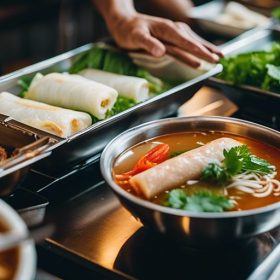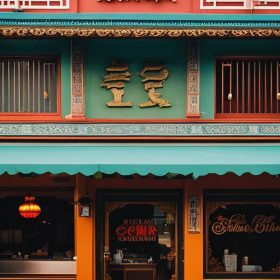Southeast Asian cuisine is known for its vibrant flavors, aromatic spices, and fresh ingredients. The region’s diverse culinary traditions have been shaped by centuries of trade and cultural exchange, resulting in a rich tapestry of flavors and cooking techniques. From the fiery curries of Thailand to the fragrant rice dishes of Bali, Southeast Asian cuisine offers a tantalizing array of dishes that are sure to delight the taste buds.
One of the defining characteristics of Southeast Asian cuisine is the use of spices and fresh ingredients. Spices such as lemongrass, ginger, garlic, and chili peppers are commonly used to add depth and complexity to dishes. Fresh herbs like cilantro, basil, and mint are also widely used to enhance the flavors of the food. In addition, Southeast Asian cuisine often incorporates a variety of vegetables, fruits, and seafood, making it a healthy and nutritious choice.
Balinese Cuisine: A Fusion of Spices and Fresh Ingredients
Balinese cuisine is a unique blend of Indonesian, Indian, Chinese, and Dutch influences. It is characterized by its bold flavors, vibrant colors, and use of aromatic spices. Some popular ingredients in Balinese cuisine include turmeric, galangal, shallots, garlic, and chili peppers. These spices are often ground into a paste called “bumbu” which is used as a base for many Balinese dishes.
One iconic Balinese dish is Babi Guling, which is a whole roasted pig stuffed with a mixture of spices including turmeric, coriander seeds, lemongrass, and garlic. Another popular dish is Nasi Goreng, which is a fried rice dish made with shrimp paste, soy sauce, chili peppers, and various vegetables. Balinese cuisine also features a wide variety of satays (grilled skewered meats) and sambals (spicy chili pastes) that are served as condiments.
Thai Cuisine: The Perfect Balance of Sweet, Sour, Salty, and Spicy
Thai cuisine is renowned for its harmonious blend of flavors, which includes sweet, sour, salty, and spicy elements. The balance of these flavors is key to creating a delicious Thai dish. Thai cuisine also emphasizes the use of fresh ingredients such as herbs, vegetables, and seafood.
One of the most famous Thai dishes is Tom Yum Soup, which is a spicy and sour soup made with lemongrass, kaffir lime leaves, galangal, chili peppers, and shrimp or chicken. Another popular dish is Pad Thai, which is a stir-fried noodle dish made with tamarind paste, fish sauce, eggs, tofu, shrimp or chicken, and various vegetables. Thai cuisine also features a wide variety of curries, such as green curry and red curry, which are made with a paste of fresh herbs and spices.
Vietnamese Cuisine: A Delightful Blend of Influences
Vietnamese cuisine is known for its fresh flavors and light yet complex dishes. It is heavily influenced by Chinese and French cuisine due to centuries of colonization and trade. Vietnamese cuisine often features a balance of flavors similar to Thai cuisine, with an emphasis on fresh herbs and vegetables.
One popular Vietnamese dish is Pho, which is a flavorful noodle soup made with beef or chicken broth, rice noodles, and various herbs and spices. Another iconic dish is Banh Mi, which is a Vietnamese sandwich made with a crispy baguette filled with grilled meats or tofu, pickled vegetables, cilantro, and chili peppers. Vietnamese cuisine also includes dishes like Bun Cha (grilled pork with vermicelli noodles) and Goi Cuon (fresh spring rolls) that showcase the use of fresh ingredients.
Appetizers: Sampling the Best of Southeast Asia
Southeast Asian cuisine offers a wide variety of appetizers that are perfect for sharing and sampling. These appetizers often showcase the bold flavors and fresh ingredients that are characteristic of the region’s cuisine.
In Balinese cuisine, one popular appetizer is Sate Lilit, which is a type of satay made with minced meat (usually pork or fish) mixed with grated coconut, spices, and herbs. Another popular Balinese appetizer is Lawar, which is a salad made with finely chopped vegetables, grated coconut, and a spicy dressing.
In Thai cuisine, one popular appetizer is Miang Kham, which is a bite-sized snack made with betel leaves filled with a mixture of roasted peanuts, dried shrimp, shallots, lime, chili peppers, and palm sugar. Another popular Thai appetizer is Tod Mun Pla, which are fish cakes made with minced fish mixed with red curry paste and deep-fried until crispy.
In Vietnamese cuisine, one popular appetizer is Goi Cuon, which are fresh spring rolls made with rice paper wrappers filled with shrimp or pork, vermicelli noodles, lettuce, herbs, and a dipping sauce. Another popular Vietnamese appetizer is Nem Nuong, which are grilled pork meatballs served with lettuce leaves, herbs, and a peanut dipping sauce.
Main Courses: Comparing Balinese, Thai, and Vietnamese Dishes
While each Southeast Asian cuisine has its own unique flavors and ingredients, there are some similarities when it comes to main courses. Rice and noodles are staple ingredients in all three cuisines and are often served as a base for various dishes. Additionally, the use of fresh herbs and spices is prevalent in all three cuisines to enhance the flavors of the dishes.
In Balinese cuisine, main courses often feature grilled or roasted meats such as Babi Guling (roast pig) or Ayam Betutu (spiced roast chicken). These dishes are typically served with steamed rice and a variety of side dishes such as sambals, pickles, and vegetable dishes.
In Thai cuisine, main courses often include stir-fried dishes such as Pad Thai or curries such as Green Curry or Massaman Curry. These dishes are typically served with jasmine rice or noodles and are often accompanied by a variety of condiments such as fish sauce, chili peppers, and lime wedges.
In Vietnamese cuisine, main courses often feature noodle dishes such as Pho or rice dishes such as Com Tam (broken rice). These dishes are typically served with a variety of toppings and condiments such as fresh herbs, bean sprouts, lime wedges, and chili peppers.
Balinese Main Courses: From Nasi Goreng to Babi Guling
Balinese cuisine offers a wide variety of main courses that showcase the unique flavors and ingredients of the region. One popular dish is Nasi Goreng, which is a fried rice dish made with shrimp paste, soy sauce, chili peppers, and various vegetables. Another popular dish is Babi Guling, which is a whole roasted pig stuffed with a mixture of spices including turmeric, coriander seeds, lemongrass, and garlic. Other popular Balinese main courses include Ayam Betutu (spiced roast chicken), Bebek Betutu (spiced roast duck), and Sate Lilit (minced meat satay).
Thai Main Courses: Tom Yum Soup, Pad Thai, and More
Thai cuisine offers a wide variety of main courses that are known for their bold flavors and aromatic spices. One iconic dish is Tom Yum Soup, which is a spicy and sour soup made with lemongrass, kaffir lime leaves, galangal, chili peppers, and shrimp or chicken. Another popular dish is Pad Thai, which is a stir-fried noodle dish made with tamarind paste, fish sauce, eggs, tofu, shrimp or chicken, and various vegetables. Other popular Thai main courses include Green Curry (made with a paste of fresh green chilies, lemongrass, and Thai basil), Massaman Curry (made with a paste of dried spices such as cinnamon, cardamom, and cloves), and Panang Curry (made with a paste of red chilies, garlic, and peanuts).
Vietnamese Main Courses: Pho, Banh Mi, and Other Must-Try Dishes
Vietnamese cuisine offers a wide variety of main courses that are known for their fresh flavors and light yet complex dishes. One iconic dish is Pho, which is a flavorful noodle soup made with beef or chicken broth, rice noodles, and various herbs and spices. Another popular dish is Banh Mi, which is a Vietnamese sandwich made with a crispy baguette filled with grilled meats or tofu, pickled vegetables, cilantro, and chili peppers. Other popular Vietnamese main courses include Bun Cha (grilled pork with vermicelli noodles), Com Tam (broken rice served with grilled meats), and Ca Kho To (caramelized fish in clay pot).
Desserts: Satisfying Your Sweet Tooth with Southeast Asian Flavors
Southeast Asian cuisine offers a wide variety of desserts that are sure to satisfy your sweet tooth. These desserts often feature tropical fruits, coconut milk, and sticky rice.
In Balinese cuisine, one popular dessert is Bubur Injin, which is a black rice pudding made with coconut milk and palm sugar. Another popular Balinese dessert is Dadar Gulung, which are pandan crepes filled with grated coconut cooked in palm sugar.
In Thai cuisine, one popular dessert is Mango Sticky Rice, which is a sweet dish made with glutinous rice cooked in coconut milk and served with ripe mangoes. Another popular Thai dessert is Tub Tim Krob, which is a refreshing dessert made with water chestnuts coated in colored tapioca flour and served in coconut milk.
In Vietnamese cuisine, one popular dessert is Che Ba Mau, which is a three-color dessert made with layers of mung beans, red beans, and green jelly served in coconut milk. Another popular Vietnamese dessert is Banh Flan, which is a Vietnamese version of crème caramel made with eggs, condensed milk, and caramel sauce.
The Best of Balinese, Thai, and Vietnamese Cuisine
In conclusion, Southeast Asian cuisine offers a diverse range of flavors and ingredients that are sure to delight any food lover. From the bold and spicy dishes of Balinese cuisine to the harmonious balance of flavors in Thai cuisine and the fresh and light dishes of Vietnamese cuisine, there is something for everyone to enjoy. So why not step out of your culinary comfort zone and explore the vibrant flavors of Southeast Asia? You won’t be disappointed!

Cuong Nguyen is a talented writer and experienced waitress at Vietnampalace.net, a renowned Vietnamese restaurant that offers an extensive menu of authentic Vietnamese cuisine. With a background in the competition of Vietnamese cuisine, Cuong brings a wealth of knowledge and expertise to the dining experience. From delicious pho dishes to fresh spring rolls, Cuong ensures that every meal is made with the freshest ingredients and authentic flavors.With exceptional service and a friendly atmosphere, Cuong takes pride in providing a memorable dining experience for every customer.
Whether you’re a vegetarian looking for options or a meat lover craving the flavors of traditional Vietnamese dishes, Cuong guarantees a delightful culinary adventure. So, visit Vietnampalace.net and let Cuong guide you through the tantalizing world of Vietnamese cuisine.



